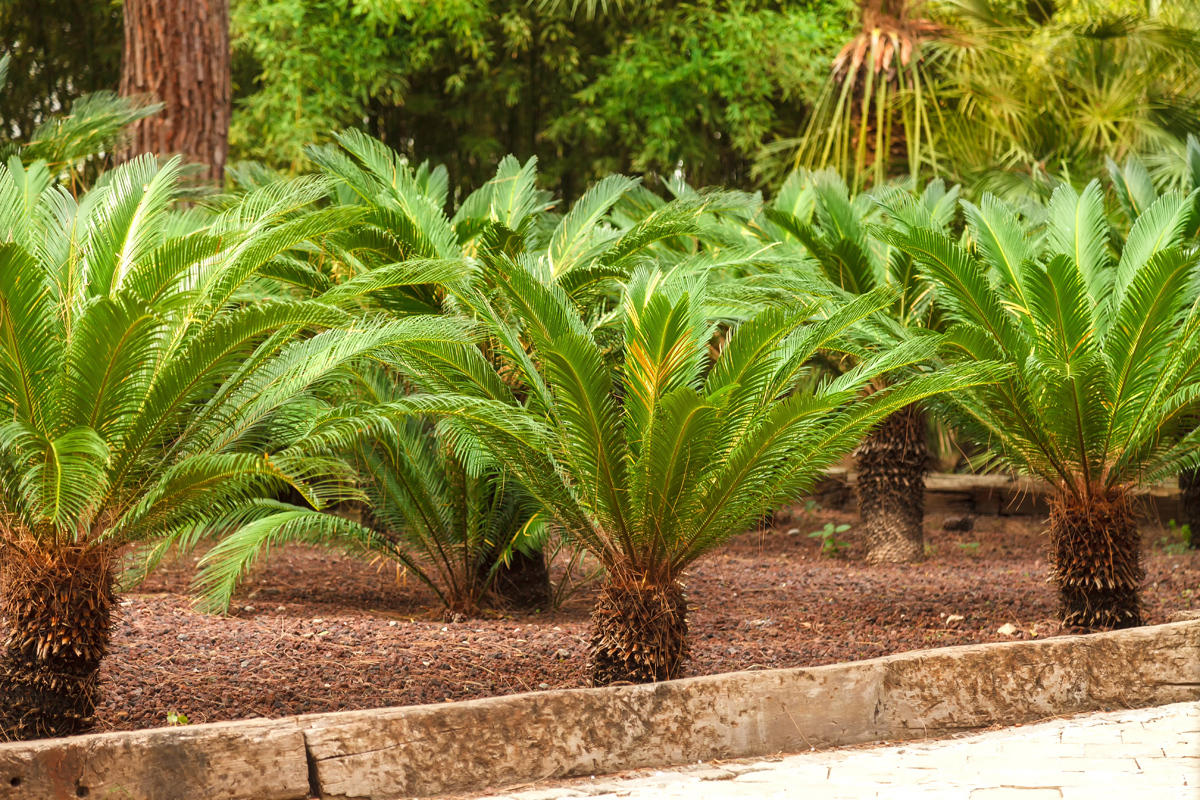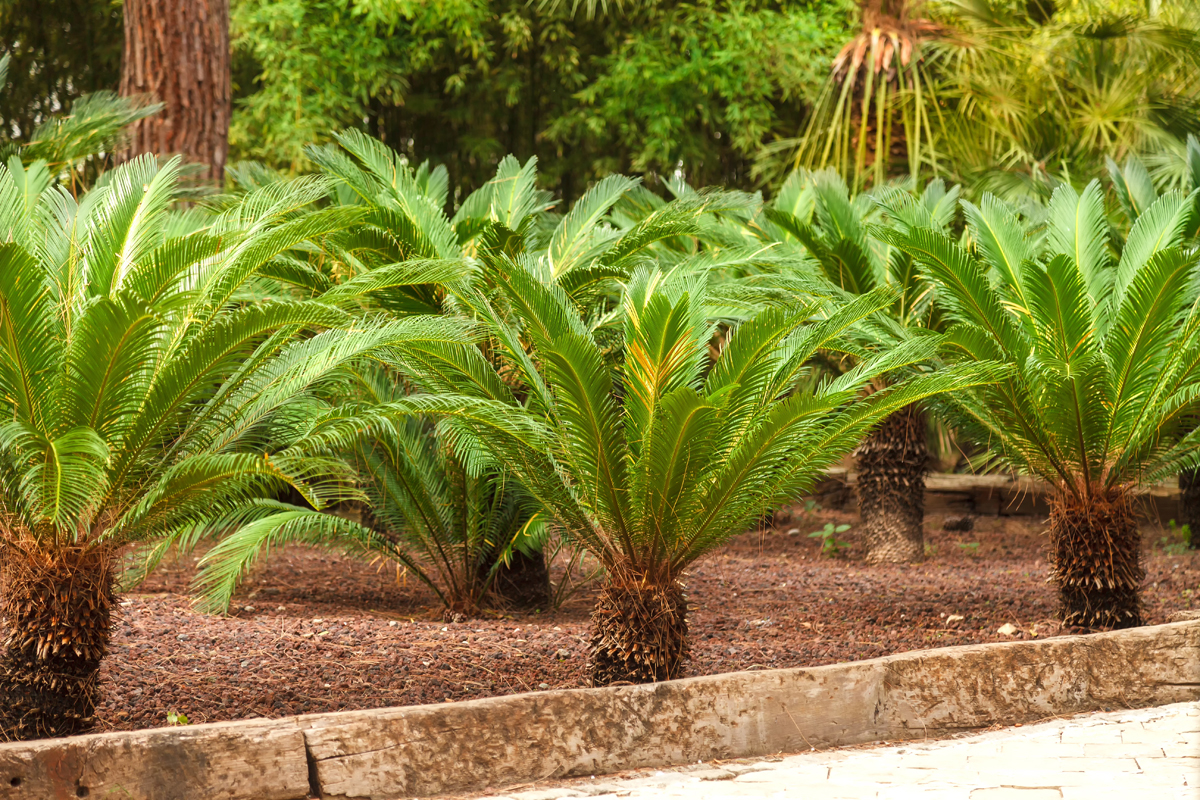
Sago palms (Cycas revoluta) have large fronds comparable to most other palm species, but they are cycads and more closely related to conifer trees. Sago palms grow in USDA plant hardiness zones 8-10, with mature trees sometimes reaching as much as 10-feet tall. What are some common sago palm issues and how can you trim this tree to save or prolong its life? Follow our complete guide to sago palm trimming below.
Sago Palm Tree Care
Oftentimes, yellow fronds can result from a nutrient deficiency. This can be remedied with a boost of fertilizer, including a citrus fertilizer. Sickly-appearing plants are sometimes brought back to health with manganese sulfate watered into the soil.
One common issue with sago palms is Manganese deficiency. Try to fertilize your palms every six weeks during growing season. Some homeowners may choose to prune the plant by simply removing yellow leaves, but this is not recommended by the tree professionals. This may ultimately cause the problem to worsen over time, gradually moving up to the next tier of leaves.
As the leaves begin to die, they can still absorb nutrients. If they are removed at this time, this could stunt plant growth overall, leaving the tree susceptible to infections. The experts recommend only pruning leaves that are brown aka dead.
Frost Damage Trimming
These palm trees can survive in temperatures as low as 15 degrees Fahrenheit and as high as 110 degrees Fahrenheit. It’s possible that some fronds could die from the frost exposure if temperatures drop below 15 degrees. When the frost threat is gone, though, any frost-damaged leaves should be removed in order to protect the tree from losing valuable nutrients.
Trimming Should Be Done Once Per Year
Homeowners should trim sago palms once each year to remove yellow-tipped, aged leaves. When the Sago palm is not producing new leaves, the best time to trim it is during the autumn. When the tree is actively growing, though, it does not like to be disturbed. It’s recommended to wear sturdy gloves and long sleeves in order to protect your hands from the spines on the fronds during this process.
Start by clipping the lowest fronds as close to the trunk as possible using clippers. Clear fronds can extend between 6 inches and 2 feet up the trunk, depending on the size of the palm, of course. Remove all brown and yellow fronds to keep your tree from becoming plagued by pests. You can also remove extra fronds during this process to expose the Sago trunk for ornamental purposes.
Getting Rid Of Flower Cones
Some gardeners do prefer to remove the flower cones growing in the heart of the palm for aesthetic reasons. The seeds growing from the flower cone are deadly poisonous to both humans and animals, making a removal very important to most homeowners.
If your Sago palm is located in a safe spot, it’s ideal to let the seed pod mature and fall off completely on its own. This ultimately protects the plant’s growing point in the center from any damage. You can remove the seeds and flower cone at any time without any risks to the Sago’s overall health.
Clearing Any Debris
Once the trimming process has been completed, remove all debris and leaf litter around the trunk. This will allow more air to reach the tree trunk and lower portions to maintain its health.
Male plants can be allergic, which is why long sleeves should be worn when pruning. Always dispose of this debris cautiously. If you put plant matter in with your yard waste or take it to the dump, make sure anyone who could come into contact with it is aware of its toxicity.
How To Trim A Sago Palm Tree
Pruning these trees is only a necessity for aesthetics. You can remove the cone from the Sago’s center carefully, being sure not to damage the growing point below. If this is left in place, the cone can break apart and fall off on its own once the new foliage takes over. If the old foliage becomes tattered, cut them off as close to the trunk as possible after new leaves have unfolded entirely.
Keep from ever excessively pruning the leaves, removing only dead or damaged leaves. Cutting away any green fronds may weaken the plant’s health overall. This will make it more susceptible to both pests and diseases.
Start this process by cutting the oldest and lowest leaves close to the trunk. In some cases, all but the very top fronds need to be removed, although this can be extreme. Refrain from trimming any sago leaves that are located between ten and two o’clock.

Tree Removal Services In Arizona
Hayward Tree is offering tree removal from above using a specialized crane. The benefit of this service is that we can remove your tree from above and avoid tearing up your yard and leaving drag marks. No broken limbs, no crushed bushes. It’s quick, efficient, and leaves your property looking clean, undisturbed, and untouched. Best of all, it’s at no additional cost to you! Contact our team today for a free estimate!




